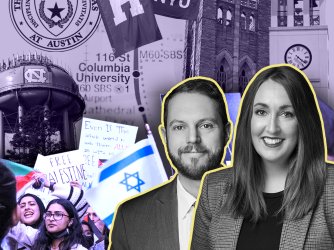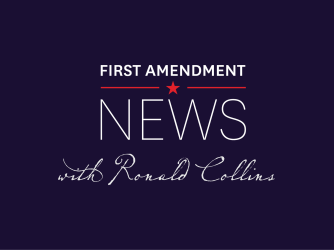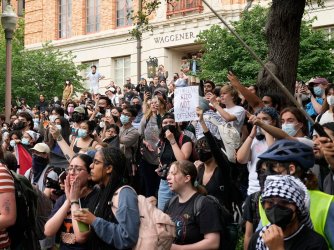Table of Contents
A Year Later, Impact of Feds’ ‘Blueprint’ Comes into Focus

Last summer, FIRE sounded the alarm about a shockingly broad definition of sexual harassment being pushed by the Departments of Education (ED) and Justice (DOJ) as a “blueprint for colleges and universities throughout the country.” Announced at the conclusion of a year-long investigation into the University of Montana’s sexual assault policies and practices, the resolution agreement and findings letter the feds labeled a “blueprint” defined sexual harassment as “any unwelcome conduct of a sexual nature,” including “verbal conduct” (i.e., speech). And this all-encompassing definition wasn’t just a general characterization of sexual harassment; rather, it was the exact policy language that ED and DOJ were requiring the University of Montana to adopt verbatim.
Unsurprisingly, the blueprint’s threat to free speech on campus was greeted with deep concern by everyone from the American Association of University Professors’ Committee on Women in the Academic Profession to Senator John McCain. Following widespread outrage, criticism, and ridicule about the blueprint’s overreach, ED’s Office for Civil Rights (OCR) first attempted to defend it, then stalled, then allowed the University of Montana to disregard some of its requirements. Finally, in a letter to FIRE sent last November, OCR seemed to back away from the blueprint, writing that “the agreement in the Montana case represents the resolution of that particular case and not OCR or DOJ policy.” In other words, OCR eventually made clear to FIRE that the feds’ self-proclaimed “blueprint” wasn’t much of a blueprint after all.
Unfortunately, and despite FIRE’s urging, OCR didn’t issue any such clarification to the thousands of colleges and universities it monitors for compliance with federal anti-discrimination laws like Title IX. As a result, new policies are being rolled out at campuses nationwide that contain the blueprint’s broad definition of sexual harassment. That’s a serious problem for freedom of speech in higher education.
For example, this past June, Georgia Southern University adopted a policy that defines sexual harassment as “unwelcome conduct of a sexual nature,” including “verbal or physical conduct of a sexual nature.” That language comes straight out of the blueprint. Same for this University of Louisiana at Monroe policy (PDF), newly revised as of April, which defines sexual harassment as “any unwelcome conduct of a sexual nature,” including “offensive verbal or physical contact [sic] of a sexual nature.” Or the policy approved earlier this month by Eastern Illinois University that defines sexual harassment as “unwelcome conduct of a sexual nature,” which may include even “a single incident” of “offensive or inappropriate language or jokes (including electronic content).” Under such sweeping definitions, speech protected by the First Amendment is subject to investigation and punishment—an unacceptable and unlawful result at public institutions like these.
Given higher education’s demonstrated commitment to prioritizing risk management, it’s a virtual certainty that these three universities aren’t alone in adopting the blueprint’s definition as operating policy. For university administrators, the calculation is straightforward: Adopting an overly broad definition of sexual harassment serves as a preventive measure against lawsuits, negative media attention, and possibly even federal investigation. After all, ED and DOJ labeled this policy the “blueprint.” So even if the agencies walked that designation back months later, and even if OCR hasn’t explicitly required adoption of the blueprint’s broad definition, it hasn’t yet publicly disavowed that idea, either—at least not in a way that might reassure anxious general counsel. Accordingly, schools play it safe by adopting the blueprint definition, accepting the risk of a First Amendment controversy or legal challenge in exchange for perceived protection against federal investigation.
Complicating the matter, institutions are displaying a worrying willingness to jettison student and faculty speech rights in a presumably well-intentioned but ultimately misguided effort to encourage students and faculty to report harassment. For example, Georgia Southern’s policy restates the blueprint’s broad definition and provides:
Students should and employees must report any unwelcome conduct of a sexual nature regardless of severity or the number of occurrences so that Georgia Southern can take steps to address harassment before it creates a hostile environment. [Emphasis in original.]
But a vast amount of speech concerning sex or gender that might be found subjectively “unwelcome” is protected by the First Amendment. Examples of speech that might trigger this illiberal spiral are nearly infinite, and as impossible to anticipate as each individual student’s shifting sensibilities: discussing an article about female genital mutilation, James Baldwin’s Giovanni’s Room, an examination of the relationship between radical feminism and transgender women, or Nicki Minaj’s new video. By pairing an emphasis on reporting with an unworkably broad definition of sexual harassment, Georgia Southern is encouraging students and faculty to report all of this obviously protected speech as “sexual harassment.” Under this policy, any expression about sex or gender that some student or faculty member might find even momentarily “unwelcome” threatens to lead to a report, an investigation, and the possibility of punishment.
The problem lies in the definition. Encouraging students to report sexual harassment and promising a “thorough investigation of all complaints of sexual harassment” is necessary and admirable when the institutional definition of sexual harassment complies with the First Amendment. But when an institution fuses these commitments to the blueprint’s impossibly broad definition of sexual harassment, as Georgia Southern has, students and faculty are taught to go straight to the authorities about any sex- or gender-related speech that they find subjectively “unwelcome.” That’s an infantilizing, ineffective posture for an institution of higher education, trivializing actual harassment and mocking freedom of expression.
Unfortunately, this is no hypothetical concern. FIRE saw a depressing number of students and faculty reporting protected speech as harassment this past academic year. Take Professor Patti Adler, who was nearly forced out of the University of Colorado at Boulder after students felt “uncomfortable” about the veteran instructor’s “Deviance in U.S. Society” course. Only after FIRE, the National Coalition Against Censorship, the American Civil Liberties Union of Colorado, the Student Press Law Center, and others raised concerns did the university finally reverse course. Or ask University of Alaska Fairbanks student Lakeidra Chavis, now editor-in-chief of the student newspaper The Sun Star. Though finally vindicated after FIRE intervened, Lakeidra’s paper was investigated for the better part of a year after a professor filed sexual harassment complaints about its content, complaining that a satirical article was “patently offensive” and that an investigation into Facebook use constituted “cyberbullying.”
And when it comes to reporting protected expression as harassment, the new academic year is already off to a flying start. Just this week, the website Total Frat Move reported that a fraternity at the University of Missouri was called before the school’s Title IX Coordinator for harassment after the frat posted a video capturing a fraternity member dressing up like a Teletubby and dancing near a sorority rush event. The Mizzou administrator correctly determined that no harassment had occurred and took no action. That’s a good and perhaps surprising outcome, given that the university’s policy defines sexual harassment as “unwelcome verbal or physical conduct of a sexual nature” and warns vaguely that “even lesser levels of sexually harassing behaviors” that don’t violate the policy “may be inconsistent with MU’s commitment to a safe and inclusive work and learning environment.” But even though this administrator didn’t abuse the discretion provided by the policy, FIRE’s case archives demonstrate that other administrators faced with similarly meritless complaints won’t react so wisely—particularly if the expressive activity prompting the complaint offends them, too.
Teaching students that sexual harassment should be defined broadly enough to include dancing Teletubbies does them a grave disservice. But as more schools adopt the blueprint’s broad definition, more protected speech will be reported as sexual harassment. The answer, as FIRE has maintained for years, is to define sexual harassment in the academic context as the Supreme Court has: conduct that is “so severe, pervasive, and objectively offensive that it can be said to deprive the victims of access to the educational opportunities or benefits provided by the school.” Davis v. Monroe County Board of Education, 526 U.S. 629, 650 (1999).
At the risk of sounding like a broken record, the Davis definition strikes the right balance between prohibiting actual harassment and protecting the robust exchange of ideas (and dancing Teletubbies) that higher education is uniquely suited to foster and sustain. A college that adopts the Davis definition in its sexual harassment policy can and should encourage students to report conduct they believe to be sexual harassment, and it has a legal and moral duty to do so. But unlike a college with the blueprint definition, a Davis college teaches its students a valuable lesson: Just because you don’t like some gender- or sex-related speech doesn’t render it actionable as harassment.
Drawing the clearest possible line between protected speech and harassment benefits everyone on campus. Unfortunately, the feds’ blueprint has muddied the waters, and we at FIRE are beginning to see that confusion reflected in college policies, just as we predicted. As FIRE President Greg Lukianoff said in a press release last November:
Colleges have been bewildered trying to reconcile their obligations under the First Amendment with the requirements of the “blueprint”—essentially an impossible task. OCR and DOJ now need to directly inform our nation’s colleges and universities that they need no longer face that dilemma.
In her letter to FIRE last fall, Assistant Secretary for Civil Rights Catherine Lhamon stated that OCR’s understanding of actionable sexual harassment is “consistent” with the definition provided by the Supreme Court in Davis. Now, OCR needs to make that clear to colleges across the country by explaining that only expression that meets the Davis standard is prohibited under the federal anti-discrimination statutes that it enforces. OCR has done this before. Given the lingering confusion caused by last year’s blueprint, it needs to do so again.
- Free Speech
- Press Freedom
- Due Process
- Faculty Rights
- Student Rights
- Harassment
- University of Montana
- Georgia Southern University
- University of Louisiana at Monroe
- University of Colorado Boulder
- University of Alaska Fairbanks
- University of Missouri - Columbia
- Departments of Education and Justice: National "Blueprint" for Unconstitutional Speech Codes
- University of Alaska Fairbanks: Complaint Over Student Newspaper's Articles Results in Months-Long Harassment Investigation
- University of Colorado at Boulder: Professor Threatened with Harassment Investigation, Forced Retirement Over Classroom Presentation
Recent Articles
FIRE’s award-winning Newsdesk covers the free speech news you need to stay informed.

Ep 213: Campus unrest - live webinar
Host Nico Perrino joins his FIRE colleagues Will Creeley and Alex Morey to answer questions about the recent campus unrest and its First Amendment implications. Timestamps 0:00 Introduction 0:41 What is FIRE?/campus unrest...

Free Speech in (college) crisis times: Thoughts and resources — First Amendment News 421

FIRE expands Free Inquiry Grant, commits $250k to support research on free speech
